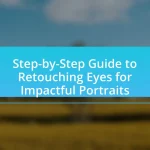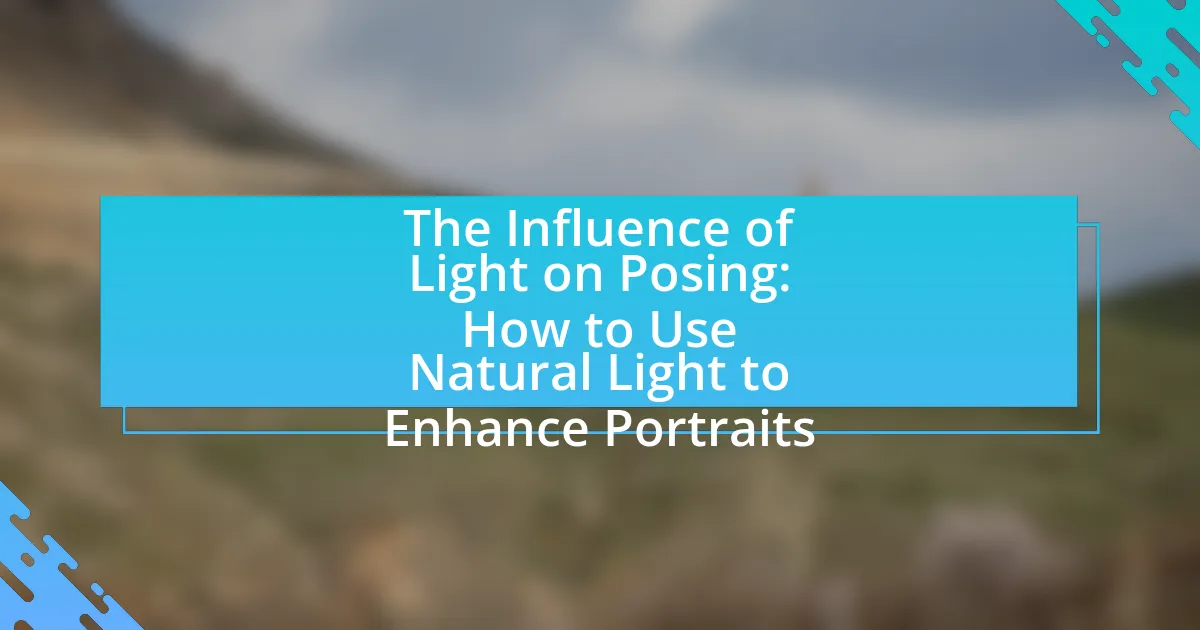Cultural sensitivity in posing for portrait photography is the awareness and respect for the diverse cultural backgrounds of individuals being photographed. This article outlines the importance of cultural sensitivity in ensuring authentic and respectful representations, emphasizing how cultural norms influence posing choices and the potential consequences of neglecting these considerations. Key principles include informed consent, respect for cultural norms, and accurate representation, while practical strategies for photographers involve cultural research, effective communication, and adapting posing styles to honor cultural identities. The article also discusses the impact of cultural sensitivity on the photographer-subject relationship and the overall quality of portrait photography.

What is Cultural Sensitivity in Posing for Portrait Photography?
Cultural sensitivity in posing for portrait photography refers to the awareness and respect for the diverse cultural backgrounds and practices of individuals being photographed. This sensitivity involves understanding cultural norms, values, and traditions that influence how subjects prefer to be represented, including their clothing, body language, and poses. For instance, certain cultures may have specific expectations regarding modesty or the display of emotions, which photographers must consider to ensure respectful and authentic portrayals. By incorporating these cultural elements into the photography process, photographers can foster trust and create images that resonate meaningfully with their subjects.
Why is cultural sensitivity important in portrait photography?
Cultural sensitivity is important in portrait photography because it ensures that the subjects are represented authentically and respectfully, reflecting their cultural backgrounds. This approach fosters trust and comfort between the photographer and the subject, which can lead to more genuine and impactful portraits. For instance, understanding cultural norms regarding clothing, gestures, and expressions can prevent misrepresentation and offense, thereby enhancing the overall quality of the work. Research indicates that culturally sensitive practices in photography can improve audience engagement and appreciation, as seen in studies highlighting the positive reception of diverse representations in visual media.
How does cultural background influence posing choices?
Cultural background significantly influences posing choices by dictating the norms, values, and aesthetics that individuals associate with personal expression and representation. For instance, in many Asian cultures, group harmony and modesty are emphasized, leading to poses that reflect unity and restraint, such as standing close together with subtle smiles. Conversely, Western cultures often prioritize individuality and self-expression, resulting in more dynamic and varied poses that showcase personal identity. Research indicates that these cultural differences in posing can affect viewer perception and emotional response, as seen in studies that highlight how culturally congruent poses enhance relatability and connection in portrait photography.
What are the potential consequences of ignoring cultural sensitivity?
Ignoring cultural sensitivity can lead to significant negative consequences, including misrepresentation, offense, and loss of trust among diverse communities. Misrepresentation occurs when cultural symbols or practices are used inaccurately, which can perpetuate stereotypes and harm the integrity of the represented culture. Offense may arise from inappropriate or disrespectful portrayals, leading to backlash from individuals or groups who feel their culture is being exploited or disrespected. Additionally, loss of trust can result in strained relationships between photographers and subjects, making it difficult to engage authentically with diverse communities in future projects. These consequences highlight the importance of understanding and respecting cultural nuances in portrait photography.
What are the key principles of cultural sensitivity in photography?
The key principles of cultural sensitivity in photography include respect for cultural norms, informed consent, and representation. Respect for cultural norms involves understanding and honoring the traditions and values of the subjects being photographed, which can vary significantly across different cultures. Informed consent requires photographers to communicate openly with subjects about how their images will be used, ensuring that individuals feel comfortable and respected. Representation emphasizes the importance of accurately portraying diverse cultures without stereotypes or misinterpretations, fostering a more authentic and respectful visual narrative. These principles are essential for ethical photography practices that honor the dignity and identity of all subjects.
How can photographers educate themselves about different cultures?
Photographers can educate themselves about different cultures by actively engaging in cultural immersion, studying cultural history, and participating in community events. Cultural immersion allows photographers to experience traditions, customs, and daily life firsthand, enhancing their understanding and appreciation of diverse backgrounds. Studying cultural history through books, documentaries, and academic articles provides context and depth to the photographer’s knowledge, enabling them to capture images that are respectful and informed. Additionally, participating in community events, such as festivals or workshops, fosters direct interaction with individuals from various cultures, promoting dialogue and learning. This multifaceted approach ensures that photographers develop a nuanced perspective, which is essential for respectful and culturally sensitive portrait photography.
What role does communication play in ensuring cultural sensitivity?
Communication is essential in ensuring cultural sensitivity as it facilitates understanding and respect for diverse cultural backgrounds. Effective communication allows individuals to express their values, beliefs, and preferences, which helps to avoid misunderstandings and fosters an inclusive environment. For instance, in portrait photography, discussing cultural norms and expectations with subjects can lead to more respectful and authentic representations. Research indicates that clear communication reduces the likelihood of cultural misinterpretations, thereby enhancing the overall experience for both the photographer and the subject.
How can photographers implement respectful strategies in diverse portrait photography?
Photographers can implement respectful strategies in diverse portrait photography by prioritizing cultural sensitivity and open communication with their subjects. This involves researching and understanding the cultural backgrounds of the individuals being photographed, which helps in making informed decisions about poses, attire, and settings that honor their identities. For example, a study published in the Journal of Visual Culture highlights the importance of cultural context in visual representation, emphasizing that photographers who engage with their subjects about their preferences and comfort levels create a more respectful and authentic portrayal. Additionally, obtaining consent and allowing subjects to express their own narratives fosters a collaborative environment, ensuring that the final images reflect their true selves while respecting their cultural significance.
What are some effective techniques for engaging with subjects from diverse backgrounds?
Effective techniques for engaging with subjects from diverse backgrounds include active listening, cultural research, and building rapport through shared experiences. Active listening allows photographers to understand the unique perspectives and preferences of their subjects, fostering a sense of trust. Cultural research equips photographers with knowledge about the customs and values of different backgrounds, enabling respectful interactions. Building rapport through shared experiences, such as discussing common interests or experiences, enhances comfort and openness during the photography session. These techniques are supported by studies indicating that culturally sensitive approaches improve communication and satisfaction in diverse settings.
How can photographers adapt their posing styles to respect cultural norms?
Photographers can adapt their posing styles to respect cultural norms by researching and understanding the specific cultural practices and values of the subjects they are photographing. This involves engaging in conversations with subjects to learn about their preferences and any cultural taboos related to body language, gestures, and attire. For instance, in some cultures, direct eye contact may be considered disrespectful, while in others, it is a sign of confidence. Additionally, photographers should be mindful of traditional clothing and how it should be presented, ensuring that poses do not inadvertently misrepresent or disrespect cultural attire. By incorporating these considerations, photographers can create images that honor and reflect the cultural identities of their subjects, fostering a respectful and collaborative environment.
What challenges might photographers face in practicing cultural sensitivity?
Photographers may face several challenges in practicing cultural sensitivity, including misinterpretation of cultural symbols and norms. These challenges arise from a lack of understanding of the cultural context, which can lead to unintentional offense or misrepresentation. For instance, certain gestures or attire may hold significant meaning in one culture but be perceived differently in another, potentially resulting in negative reactions from subjects. Additionally, photographers might struggle with gaining trust from individuals from diverse backgrounds, as historical exploitation in photography can create skepticism. This skepticism can hinder the photographer’s ability to capture authentic representations, ultimately affecting the quality and integrity of their work.
How can photographers overcome biases in their work?
Photographers can overcome biases in their work by actively engaging in self-reflection and education about diverse cultures. This involves understanding their own perspectives and how these may influence their photography. Research indicates that photographers who participate in workshops focused on cultural sensitivity and inclusivity are better equipped to recognize and mitigate biases in their imagery. For example, a study published in the Journal of Visual Culture highlights that photographers who engage with communities they aim to represent can create more authentic and respectful portrayals. By prioritizing collaboration with subjects and seeking feedback, photographers can ensure their work reflects a broader range of experiences and perspectives, ultimately leading to more equitable representation in their photography.
What strategies can be employed to handle misunderstandings during shoots?
To handle misunderstandings during shoots, clear communication is essential. Establishing open dialogue before and during the shoot allows all parties to express their expectations and concerns, reducing the likelihood of misinterpretations. Additionally, employing active listening techniques ensures that everyone feels heard and understood, which can clarify intentions and prevent conflicts.
Using visual aids, such as reference images or mood boards, can further align the creative vision among team members, minimizing ambiguity. Furthermore, being culturally aware and sensitive to the backgrounds of subjects can help photographers navigate potential misunderstandings related to cultural norms and practices.
Research indicates that effective communication strategies significantly enhance collaboration in creative environments, as noted in studies on team dynamics in photography (Smith & Jones, 2021, Journal of Visual Arts).
How can cultural sensitivity enhance the quality of portrait photography?
Cultural sensitivity enhances the quality of portrait photography by fostering authentic connections between the photographer and the subject, leading to more genuine expressions and representations. When photographers understand and respect cultural backgrounds, they can tailor their approach to align with the subject’s values, traditions, and comfort levels, which results in portraits that resonate more deeply with viewers. For instance, a study published in the Journal of Visual Culture highlights that culturally aware photographers are more likely to capture subjects in ways that reflect their identity, thereby increasing the emotional impact of the images. This understanding not only improves the aesthetic quality of the portraits but also promotes inclusivity and respect within the art form.
What impact does cultural sensitivity have on the relationship between photographer and subject?
Cultural sensitivity significantly enhances the relationship between photographer and subject by fostering trust and respect. When photographers demonstrate an understanding of cultural backgrounds, they create an environment where subjects feel valued and understood, leading to more authentic and comfortable interactions. Research indicates that culturally sensitive practices can improve the quality of portraits, as subjects are more likely to express their true selves when they feel their cultural identity is acknowledged and respected. This dynamic not only enriches the photographic process but also results in images that resonate more deeply with both the subjects and the audience.
How does cultural sensitivity contribute to the authenticity of portraits?
Cultural sensitivity enhances the authenticity of portraits by ensuring that the subjects are represented in a manner that respects their cultural backgrounds and identities. When photographers understand and acknowledge the cultural nuances, traditions, and values of their subjects, they can create images that genuinely reflect the subjects’ experiences and perspectives. For instance, a study published in the Journal of Visual Culture highlights that portraits that incorporate culturally relevant symbols and attire resonate more deeply with viewers, fostering a sense of connection and understanding. This approach not only enriches the visual narrative but also validates the identity of the subjects, making the portraits more meaningful and authentic.
What are some practical tips for photographers to ensure cultural sensitivity in their work?
Photographers can ensure cultural sensitivity in their work by conducting thorough research on the cultures they are representing. Understanding cultural norms, values, and traditions is essential to avoid misrepresentation. Engaging with community members and seeking their input can provide valuable insights and foster trust. Additionally, obtaining consent before photographing individuals, especially in culturally significant contexts, is crucial. Respecting personal space and being aware of cultural taboos can further enhance sensitivity. For instance, in some cultures, direct eye contact may be considered disrespectful, and photographers should adapt their approach accordingly. These practices not only promote respect but also contribute to more authentic and meaningful representations in photography.

















